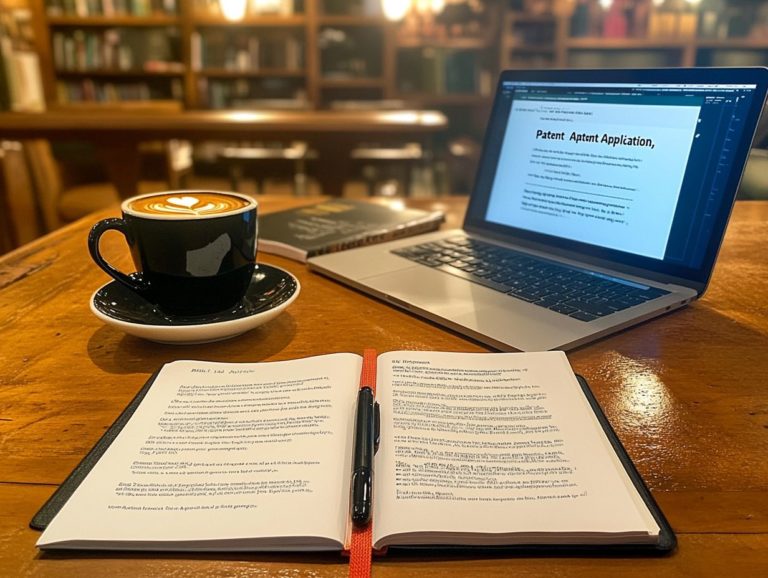How to Navigate Patent Litigation
Patent litigation can seem overwhelming. But understanding it is essential for your success.
This article breaks down the legal processes and common cases you’ll face. It also highlights essential steps for preparation.
From understanding infringement claims to navigating the courtroom, you ll discover crucial insights that can make a difference!
Contents
Key Takeaways:
- Proper preparation includes gathering evidence and building a strong legal team.
- Understanding different types of patent litigation is crucial.
- Conduct proper patent searches to avoid litigation.
Understanding Patent Litigation
Understanding patent litigation is vital for patent holders, R&D teams, and innovation teams. This area involves complex legal processes surrounding patent infringement and the protection of exclusive rights related to intellectual property.
Patent litigation comprises multiple stages, from the initial prosecution of a patent to trial preparation and potential resolutions, as detailed in understanding IP litigation.
By familiarizing yourself with this legal landscape, you can grasp the details of patent rights, ensuring your inventions and designs are well-protected under the jurisdiction of the United States Patent and Trademark Office (USPTO).
The Patent Litigation Process
The legal process in patent litigation consists of various stages, each requiring meticulous attention to detail to uphold your patent rights. Knowing how to prepare for an IP litigation case can greatly enhance your chances of success.
Starting with initial pre-trial motions, you’ll establish jurisdiction and evaluate the validity of claims. Next is the discovery phase, where both parties gather crucial evidence every detail matters.
During this time, litigation strategy becomes critical as you collaborate with stakeholders, including patent attorneys and expert witnesses, to build a compelling case. Understanding how to track IP litigation trends effectively can also enhance your overall approach.
As you prepare for trial, focus on evidence presentation, ensuring all information is organized and persuasive.
Don t overlook post-trial actions; appeals or settlement negotiations may arise, showcasing the dynamic relationship between legal strategies and enforcing your patent protections.
Common Types of Patent Litigation
Common types of patent litigation primarily involve patent infringement claims and invalidity claims.
Both significantly influence patent rights and the subsequent legal proceedings, shaping the landscape of intellectual property law.
Infringement Claims
Infringement claims arise when a party uses, sells, or manufactures a patented invention without permission from the patent holder, violating patent rights.
To effectively prove patent infringement, you must demonstrate that the accused product falls under the claims defined in the patent. This often requires a detailed technical analysis, supported by expert witnesses who clarify the intricacies of the patented technology.
Key forms of evidence in such cases include documentation of sales, marketing materials, and comparative analysis of the patented invention against the accused product.
Notable cases, such as Markman v. Westview Instruments, highlight the importance of claim construction, where courts interpret the scope of patent claims.
Legal precedents reveal a range of potential outcomes, from injunctions that restrict the infringing party’s activities to monetary damages to compensate the patent holder for any losses incurred.
Invalidity Claims
Invalidity claims question a patent’s validity. They argue that the patent should not have been approved because of existing technologies or ideas.
If a competitor suspects a patent is based on common knowledge, they might file an invalidity claim. This can lead to serious consequences for patent holders, including losing exclusive rights and facing high legal costs.
In high-stakes cases like the Apple vs. Samsung dispute, courts carefully examined patent validity, demonstrating how invalidity claims can change the course of significant legal battles and alter market dynamics.
Steps to Prepare for Patent Litigation
Preparing for patent litigation requires a careful strategy focused on gathering compelling evidence and thorough trial preparation to effectively safeguard your patent rights, including understanding how to protect your IP rights during litigation.
Every detail matters; a well-crafted approach can significantly influence your case’s outcome.
Gathering Evidence
Gathering evidence is key to your case. It helps you build a strong argument during the discovery phase.
You’ll use document requests to get important records. Depositions let you capture sworn testimonies, while interrogatories allow you to ask specific questions and get detailed answers.
Each of these techniques is crucial for uncovering facts and building a comprehensive understanding of the case, highlighting the need for a careful approach during discovery.
Building a Strong Legal Team
A strong legal team is crucial for navigating patent litigation. You need skilled patent attorneys and knowledgeable expert witnesses on your side to ensure you understand how to optimize your IP portfolio against litigation.
Patent attorneys provide legal expertise, while expert witnesses help explain complex ideas to the jury. Together, they enhance your credibility and strengthen your case.
Navigating the legal landscape of patent litigation requires a nuanced understanding of the essential steps involved in both initiating a lawsuit and crafting a response to one, including understanding patent infringement in litigation.
It s important to grasp the intricacies of this process to effectively advocate for your interests.
Filing a Lawsuit
To file a lawsuit, start with a formal complaint outlining the alleged patent infringement. This document sets the stage for your legal journey.
Before drafting, check the right court to ensure it can handle your case. A strong complaint includes clear facts, details on the infringement, and specific requests for relief.
This approach leads to a more efficient resolution of your litigation.
Don t wait! Consult a patent attorney today to protect your rights.
Responding to a Lawsuit
Responding to a lawsuit requires careful thought about your options. As a defendant, you need to navigate this complex situation with strategies that fit your specific case.
Consider filing counterclaims to protect your rights. This can include questioning the validity of the patent or accusing the plaintiff of infringing on your products.
You may also file motions to dismiss the case. These can be based on the court’s authority or lack of sufficient claims.
Possible Outcomes and Resolutions
Patent lawsuits can lead to several outcomes, including settlements and court decisions. Understanding IP litigation strategies for patent holders can help you plan your next steps.
Settlements
Settlements are a common way to resolve patent disputes. They allow you to avoid the uncertainty of a trial, saving time and resources.
During negotiations, evaluate both sides’ patent claims carefully. Factors like the length of the legal battle and potential media attention can influence your agreement.
Effective negotiation can lead to solutions that minimize risks for everyone involved.
Court Decisions
Court decisions can significantly impact your patent rights. These rulings shape competition and can affect your funding decisions.
Various elements influence these decisions, such as the clarity of your claims and the expert testimony you provide.
Selecting a jury is important; their perceptions can sway outcomes. Damages awarded can vary widely, reflecting the seriousness of the infringement.
Take the eBay v. MercExchange case as an example. It set important guidelines for injunctions and damages, considering market context and harm done.
Tips for Avoiding Patent Litigation
To steer clear of patent disputes, conduct thorough searches. Partner with an experienced attorney to better understand patent rights.
Properly Conducting Patent Searches
Thorough patent searches help protect your innovations. Understanding intellectual property is key for inventors and businesses alike.
Utilize various databases, including resources from the U.S. Patent and Trademark Office (USPTO). Use advanced techniques like keyword searches to uncover relevant patents.
Thorough searches guard against litigation and help refine your ideas. This can enhance your competitiveness and foster innovation.
Working with an Experienced Attorney
Working with an experienced attorney is essential for crafting a comprehensive litigation strategy that effectively safeguards your patent rights, especially when you know what to expect during an IP litigation process.
Their expertise enables you to navigate the intricate patent landscape with confidence, significantly reducing the risk of costly infringements.
When you partner with seasoned legal professionals, you can strategically evaluate your intellectual property portfolio, ensuring it is robustly protected while implementing proactive measures against potential threats.
Effective collaboration often involves conducting in-depth market analyses and patent searches, allowing you to identify possible overlaps. This foresight not only strengthens your position in the marketplace but also lays a solid foundation for future innovations, making this legal partnership an invaluable asset in the competitive tech environment.
Frequently Asked Questions
What is patent litigation?
Patent litigation is a legal process in which a patent holder sues someone for infringing on their patent rights. This typically involves a complex legal battle to determine the validity of the patent and whether the accused party has infringed upon it.
What steps should be taken before initiating patent litigation?
Before initiating patent litigation, it is important to conduct a thorough analysis of your patent and the potential infringing activity. This can involve consulting with a patent attorney and collecting evidence to support your case.
What are the potential outcomes of patent litigation?
The potential outcomes of patent litigation include a ruling in favor of the patent holder, a ruling in favor of the accused infringer, or a settlement between the two parties. In some cases, the court may also order an injunction to stop the infringing activity or award damages to the patent holder.
How long does patent litigation typically take?
The timeline for patent litigation can vary greatly depending on the complexity of the case and the court’s schedule. It can take anywhere from several months to several years for a final ruling to be reached.
What are the costs associated with patent litigation?
The costs associated with patent litigation can be significant, including legal fees, expert witness fees, and court costs. It is important to carefully consider the potential costs before deciding to pursue patent litigation.
Are there alternatives to patent litigation?
Yes, there are alternatives to patent litigation such as mediation or arbitration. These methods can be less expensive and time-consuming than traditional litigation and may result in a mutually beneficial resolution for both parties.




